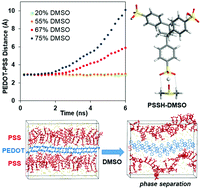A theoretical mechanistic study on electrical conductivity enhancement of DMSO treated PEDOT:PSS†
Abstract
Conductive polymers have been attracting attention for decades due to their promising applications in photovoltaic cells and thermoelectrics. Among them, poly(3,4-ethylene dioxythiophene):poly(styrene sulfonate) (PEDOT:PSS) is the most extensively studied one with the features of high water dispersibility, transparency and thermal stability as well as having relatively high electrical conductivity (EC). Nevertheless, the EC of as-prepared PEDOT:PSS is still unsatisfactory for real applications. Experimental studies on PEDOT:PSS have showed that its low EC could be elevated by more than 3 to 4 orders of magnitude by polar solvent treatment. However, the mechanism of this enhancement remains unclear. In this work, dimethyl sulfoxide (DMSO) treated PEDOT:PSS polymers are studied using multiscale molecular modeling, including density functional theory (DFT) calculations and molecular dynamics (MD) simulations. We elucidate the mechanism of EC enhancement at the molecular level, demonstrating that DMSO dissolves the PSS shell to release the conductive PEDOT in the core for self-aggregation, leading to subsequent phase separation of PEDOT and PSS by charge screening. These findings are important for the selection of alternative solvents for further EC enhancement of PEDOT:PSS in thermoelectric applications.



 Please wait while we load your content...
Please wait while we load your content...